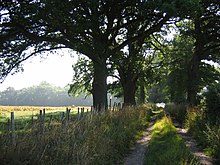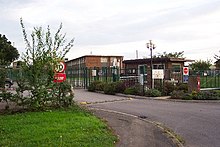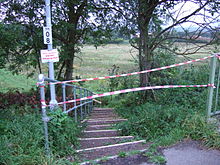2007 United Kingdom foot-and-mouth outbreak
One month and ten days after the first diagnosis a final incidence of 2007 was identified and dealt with 13 miles (21 km) north of the first diseased animal.
[2] Symptoms of foot-and-mouth disease were first reported late on 2 August 2007 on farmland in Normandy in Surrey, which was subsequently isolated and placed under restrictions.
[6][7] The following day the Chief Veterinary Officer (CVO) Debby Reynolds confirmed that initial testing revealed that 60 cattle were infected with foot-and-mouth disease and[8][9] that other potential cases were being investigated.
[13] The Merial Animal Health site was also identified as a possible source of the infection, as they were one of four European laboratories authorised to handle the strain to produce vaccines.
[35] As required by European Union regulations, all exports of animal and meat products of species affected by the outbreak were halted from the United Kingdom.
[36] A net total of 2160 animals were culled in the affected zones over the 58 day outbreak period (982 cattle, 1128 pigs, 43 sheep and seven goats).
This compares to a total loss of around £3 billion and the culling of around four million animals (85% sheep, 12% cattle, 3% pigs) during the 2001 outbreak which lasted for 221 days.
"[38] King, a former head of molecular biology at the IAH, said "As far as I am concerned the authorities have failed to find any chink in the armoury of the establishment’s bio-security.
It reported that traces of the virus were found in a pipe at the Pirbright institute running from Merial to the government's treatment plant.
The report hypothesises that site workmen conveyed the virus to the Normandy farm en route home from work.
[43][44] An independent investigation carried out by Brian Spratt found that due to the recognition that infected material could survive the initial citric acid disinfection stage within the Merial plant, the effluent system up to the final caustic soda treatment plant was considered by Defra inspectors to be within the scope of Containment Level 4, yet it appeared not to have been subject to regular inspection and there was evidence of leakage both from broken pipework and via unsealed, overflowing manholes: 23.
The possibility of infectious virus being discharged to the effluent pipes was recognised by the Defra inspectors and, for this reason, the drainage system that leads to the caustic soda final treatment plant is considered part of Category 4 containment at Pirbright.
The effluent pipes from IAH and Merial to the caustic soda final treatment plant are old and appear not to have been subject to regular thorough inspections to ensure their integrity.
At the time Surrey Police Assistant Chief Constable Mark Rowley said "So far, two photographers have been arrested for breaching cordons, despite the obvious need to protect the area and clear signs prohibiting entry.
The idea that anyone not wearing protective clothing and taking no bio-security measures is trampling through a potentially contaminated area of the countryside is beyond belief."
[45] The two photographers, Philip Hollis of The Daily Telegraph and James Purkiss, were later found guilty under the Animal Health Act for ignoring prohibitions and entering protected sites.





